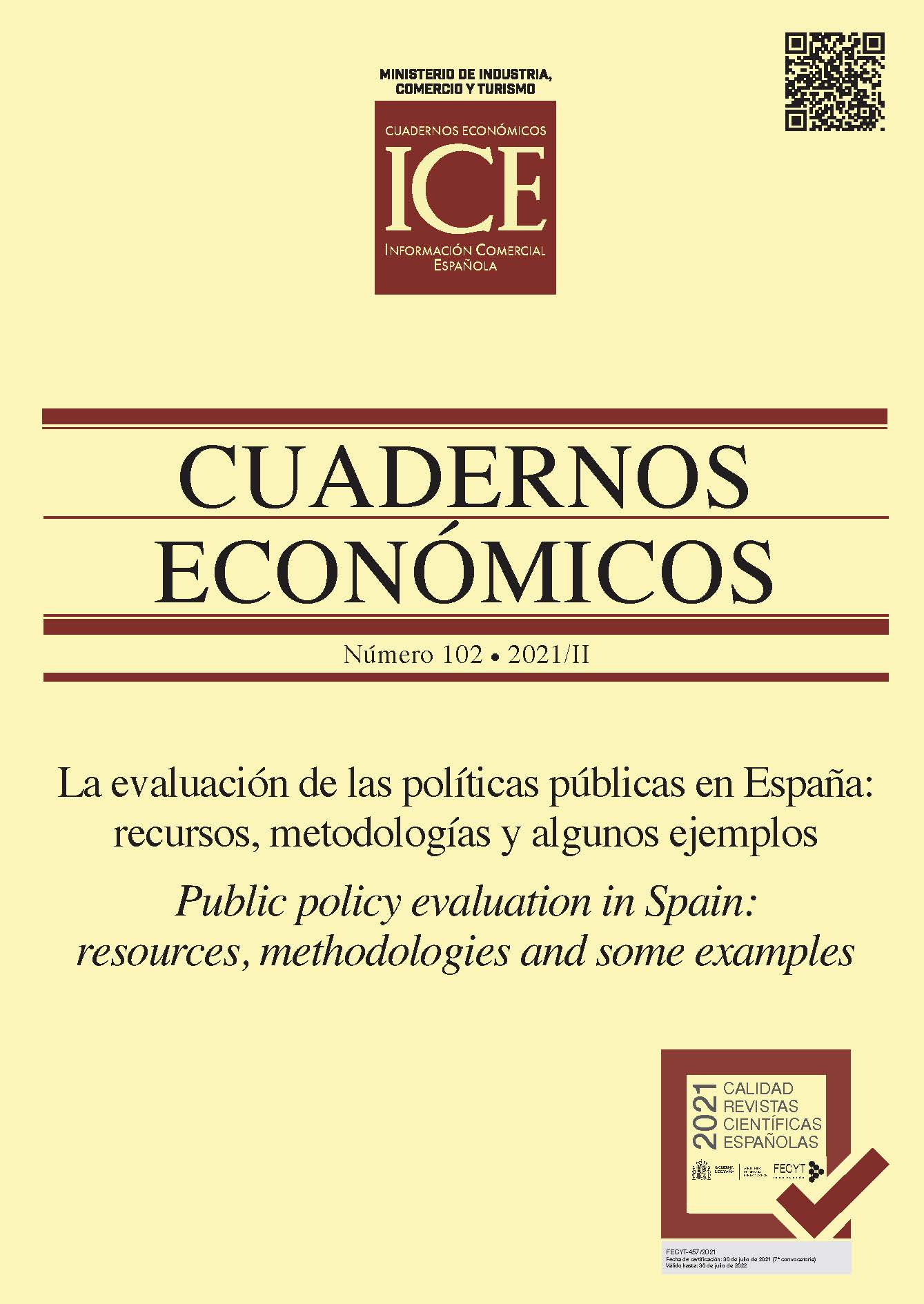Active labor market policies for workers with difficult job placement experiences: an impact evaluation
##plugins.themes.bootstrap3.article.sidebar##
Downloads
##plugins.themes.bootstrap3.article.main##
In this paper, an impact assessment exercise of an active labour market policy aimed at hard-to-place unemployed is conducted. These are the so-called local employment initiatives and in particular, two measures developed in Andalusia during the years 2016-2018: the Emple@Joven and Emple@30+ programs. Using matching methods, it is found that the Emple@Joven program, aimed at unemployed people under the age of 30, did not increase the employment levels for the beneficiaries of the program and that the Emple@30+ program, aimed at unemployed people over the age of 30, only significantly helped the unemployed people without working experience or those who had been out of the labour market for more than 24 months. Therefore, apparently, these measures that provided a working experience between 3 and 6 months, only seemed to be effective for very specific groups with special difficulty in accessing the labour market on their own. These results, thus, point to the need of a better ex-ante profiling of active employment policies’ recipients, offering them only to those who are expected to gain the most in terms of their level of employability, offering them a better and more stable insertion in the labour market.
##plugins.themes.bootstrap3.article.details##
- Jorge Casanova, Florentino Felgueroso, José Ignacio García Pérez, Sergi Jiménez-Martín, Statistical Profiling: an instrument for evaluating the impact of Incorpora , Cuadernos Económicos de ICE: No. 102 (2021): The evaluation of public policies in Spain: resources, methodologies and some examples
Arellano, F. A. (2010). Do training programmes get the unemployed back to work? A look at the Spanish experience. Revista de Economía Aplicada, 18(53), 39-65. https://www.researchgate.net/publication/47647401_Do_Training_Programmes_Get_the_Unemployed_Back_to_Work_A_Look_at_the_Spanish_Experience
Arranz, J. M., García Serrano, C., & Hernanz, V. (2013). Active labour market policies in Spain: A macroeconomic evaluation. International Labour Review, 152(2), 327-348. https://doi.org/10.1111/j.1564-913X.2013.00182.x
Blázquez, M., Herrarte, A., & Sáez, F. (2019). Training and job search assistance programmes in Spain: The case of long-term unemployed. Journal of Policy Modeling, 41(2), 316-335. https://doi.org/10.1016/j.jpolmod.2019.03.004
Caliendo, M. (2006). Microeconometric evaluation of labour market policies. Springer Science & Business Media.
Card, D., Kluve, J., & Weber, A. (2010). Active labour market policy evaluations: A meta?analysis. The economic journal, 120(548), F452-F477. https://doi.org/10.1111/j.1468-0297.2010.02387.x
Card, D., Kluve, J., & Weber, A. (2018). What works? A meta analysis of recent active labor market program evaluations. Journal of the European Economic Association, 16(3), 894-931. https://doi.org/10.1093/jeea/jvx028
Cueto, B., & Mato, F. J. (2009). A nonexperimental evaluation of training programmes: regional evidence for Spain. The Annals of Regional Science, 43(2), 415-433. https://doi.org/10.1007/s00168-008-0214-2
De la Rica, S. (2015). Políticas activas de empleo: una panorámica. Fedea policy papers, 1, 1-32. https://documentos.fedea.net/pubs/fpp/2015/01/FPP2015-01.pdf
Escudero, V., Kluve, J., López Mourelo, E., & Pignatti, C. (2019). Active labour market programmes in Latin America and the Caribbean: Evidence from a meta-analysis. The Journal of Development Studies, 55(12), 2644-2661. https://doi.org/10.1080/00220388.2018.1546843
Felgueroso, F., García-Pérez, J. I., & Jiménez, S. (2018). Perfilado estadístico: un método para diseñar políticas activas de empleo. Editorial Centro de Estudios Ramón Areces. https://www.fundacionareces.es/recursos/doc/portal/2018/05/03/perfilado-estadistico.pdf
García-Pérez, J. I., & Rebollo-Sanz, Y. F. (2009a). The use of Permanent Contracts Across Spanish Regions: Do regional wage subsidies work? Investigaciones Económicas, 33(1), 97-130. https://www.redalyc.org/pdf/173/17312887004.pdf
García-Pérez, J. I., & Rebollo-Sanz, Y. F. (2009b). Do wage subsidies affect the subsequent employment stability of permanent workers?: the case of Spain. Moneda y Crédito, 228, 65-103. http://citeseerx.ist.psu.edu/viewdoc/download?doi=10.1.1.529.8719&rep=rep1&type=pdf
Gerfin, M., & Lechner, M. (2002). A microeconometric evaluation of the active labour market policy in Switzerland. The Economic Journal, 112(482), 854-893. https://doi.org/10.1111/1468-0297.00072
Hohmeyer, K., & Wolff, J. (2010). Direct job creation revisited. Is it effective for welfare recipients and does it matter whether participants receive a wage? IAB, Discussion Paper No. 21/2010, 1-62. http://doku.iab.de/discussionpapers/2010/dp2110.pdf
INAEM, Instituto Aragonés de Empleo. (2015). Estudio sobre la valoración económica y social de las políticas activas del Instituto Aragonés de Empleo. https://inaem.aragon.es/sites/default/files/inaem_2010-2014_25112015.pdf
Kluve, J. (2010). The effectiveness of European active labor market programs. Labour economics, 17(6), 904-918. https://doi.org/10.1016/j.labeco.2010.02.004
Kuddo, A. (2009). Employment services and active labor market programs in Eastern European and Central Asian countries. SP, Social Protection Discussion Paper No. 0918, 1-87. http://documents.worldbank.org/curated/en/801251468170040578/Employment-services-and-active-labor-market-programs-in-Eastern-European-and-Central-Asian-countries
Leuven, E., & Sianesi, B. (2003). PSMATCH2: Stata module to perform full Mahalanobis and propensity score matching, common support graphing, and covariate imbalance testing. Statistical Software Components.
Smith, J. A., & Todd, P. E. (2005). Does matching overcome LaLonde's critique of nonexperimental estimators? Journal of econometrics, 125(1-2), 305-353. https://doi.org/10.1016/j.jeconom.2004.04.011
Ramos, R., Suriñach, J., & Artís, M. (2009). La efectividad de las políticas activas de merca¬do de trabajo para luchar contra el paro. La experiencia de Cataluña (Working Papers No. 2009/19). Research Institute of Applied Economics. http://www.ub.edu/irea/working_papers/2009/200919.pdf
Rebollo-Sanz, Y. F. (2018). El Modelo de Perfilado Estadístico: una herramienta eficiente para caracterizar a los demandantes de empleo. En F. Felgueroso, J. I. García-Pérez, & S. Jiménez (eds.), Perfilado estadístico: un método para diseñar políticas activas de empleo (pp. 17-93). Editorial Centro de Estudios Ramón Areces. https://www.fundacionareces.es/recursos/doc/portal/2018/05/03/perfilado-estadistico.pdf
Roy, A. S., & Wong, G. (2000). Direct job creation programs: Evaluation lessons on cost-effectiveness. Canadian Public Policy/Analyse de Politiques, 26(2), 157-169. https://doi.org/10.2307/3552553


